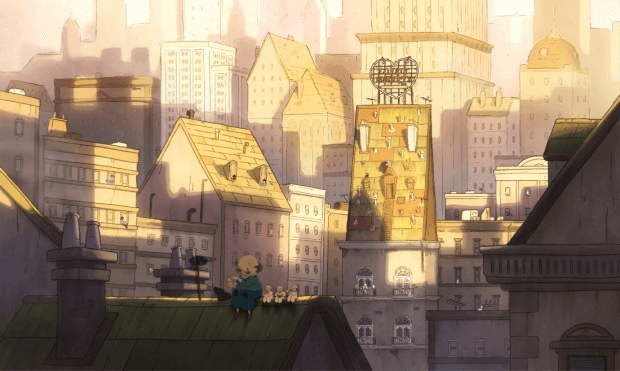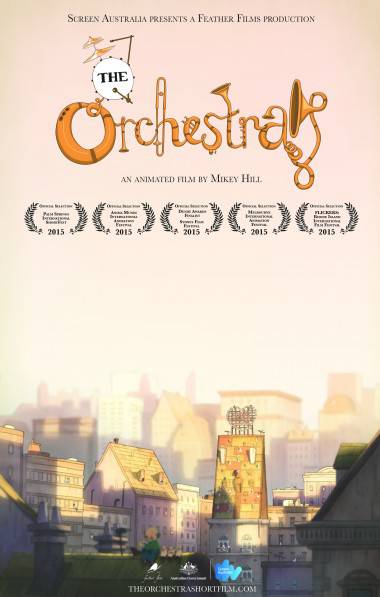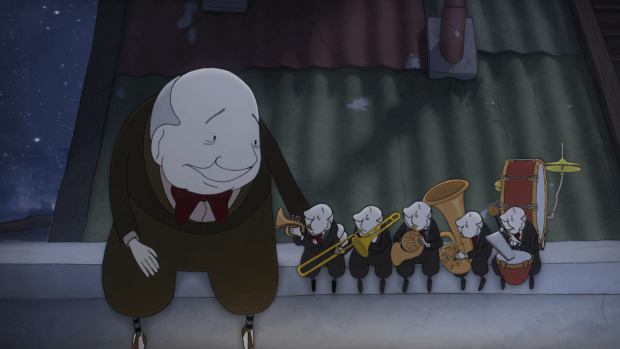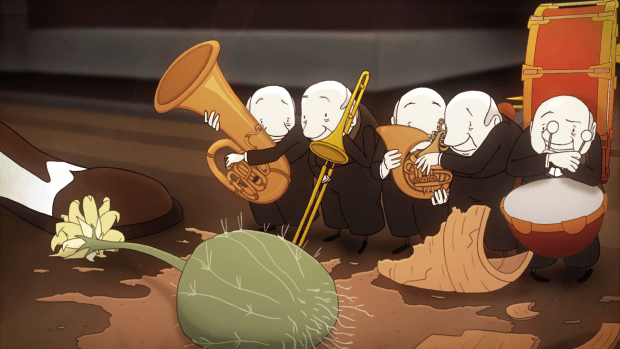An Interview with The Orchestra Director Mikey Hill
In a world filled with beautiful music, Vernon always seems to strike the wrong note.
After The Orchestra premiered at Oh Yeah Wow’s Melbourne based studio, the film has begun it’s journey on the festival circuit. The Orchestra is a film set in a reality where every person has there own set of musician’s providing a soundtrack to there daily lives. The lead character is a charming old man, Vernon, who continuously struggles to fit into the harmony of this alternate world. Skwigly was lucky enough to catch up with the director Mikey Hill at the Melbourne International Animation Festival and interview him about his circuitous journey into animation and the production his third hand drawn production.
So starting from the beginning would you tell us how you got into animation?
I could go way back to the beginning, when I was seven years old I loved the hell out of my dog, I had that childish romantic notion of saving animals, I wanted to save all the animals in the world based on my loving relationship with my dog, Mitzy. I became fixated on becoming a veterianen, I stuck with it, I studied really hard in high school, managed to get a good mark and I got into vet school in Perth. I grew up in Adelaide. At the age of seventeen, and I was a pretty sheltered seventeen year old, I travelled over to Perth and studied for five years and became a Vet. I really enjoyed the study, and challenging myself, but I found when I started to deal with the realism of being a Vet in my final year, I sensed it wasn’t for me. It’s very scientific and very stressful, and I discovered I have more of an artistic temperament than a scientific, diagnostic one. I got this sense, but I’d come so far off four and a half years of studying, I gave it a shot and practiced as a vet for five years. Travelled the world as a Vet and after a few years that feeling solidified as it was a stressful and depressing job. Running parallel with that I was always a drawer, I draw silly little cartoons. I love The Far Side, by Gary Larson, it’s this one panelled comic strip, he would tell these amazing stories just through one simple image. It’s a snippet in time, you’d get a sense of a build up of a situation, and he would capture this moment of realisation for the character, (snaps fingers). I really love that, so I was doing that all the way through studying, even as a vet I was running a website called illogic cartoons. I used the cartoons from this website for my portfolio, so I made the decision in 2005 that I wanted to try animation. I’d been to MIAF and caught a few screenings of that, and I was really fascinated by animation and moving image. I hadn’t really explored moving image before just these still cartoons, so I taught myself flash.
Did it involve animals?
No not really actually, most of my animated works are about human characters. Weird human characters, but I haven’t really explored the Disney-esque or Warner Brother’s animal theme. I have wondered about setting a series in a Vet Hospital, because I have that background knowledge there.
So you then proceeded to go to the Uni of RMIT in Melbourne?
In 2005 I quit being a Vet and I made this crappy little cartoon, because I thought to get into animation school, I’m going to need some sort of animation in my portfolio. So after teaching myself flash, it wasn’t even Adobe back then, it was Macromedia Flash. I took a Blur song and made a 2/3 minute film clip for that, which was dreadful. I presented it in my interview, and the animation director said “Oh, I can see that you have a sense of timing..” he didn’t say it was good, but I guess he saw potential and I was taken on for a Masters degree. I focused mainly on storytelling, but at the same time I’d obviously came to the animation masters from a circuitous route, so I was pretty driven to learn the software and produce good quality work.
Your latest film The Orchestra is a hand drawn fifteen minute short? Why did you chose the technique hand drawn?
It’s the medium that I’ve always worked in. When I was a kid, I was always drawing rather than sculpting or painting, so it just seemed a natural medium for me.
What inspired the story?
It was an idea that came to me, when I was sitting on the tram into Melbourne, and I noticed that no one interacts with each other anymore. We all have our heads in our screens, and most people have ear phones in and everyone is listening to music. Everyone technically does have a soundtrack to there life it just we can’t necessarily hear it. I was doing the same, listening to a really strong trumpet melody, and I’m a bit of a people watcher so I don’t read a book or look at my phone, I just look at other people. As I watched I imagined everyone having little musicians, playing into there ears and that was the spark of the idea.
That’s super interesting, when I was on the tram earlier today, I had a moment where there was a young scallywag dressed in joggers and his earphones fell out and he was listening to TLC and I did a double take because I did not see that coming.
Haha, well that’s funny because in some of the crowd scenes, we had unexpected musicians follow them around, so there’s a business man with a barbershop quartet. That sort of thing where is subverts the expectations of what they would normally be listening to.
Do you think you would ever continue this alternate reality?
Perhaps in the future. I think I might be done with it for now, because it was such a big effort, it took five to six years to make. From the original conception of the idea, through to finishing it. Which I guess is common for a lot of animation, the pre production takes forever. Plotting out the storyboards and the animatics, for us even the script took almost two years just to get it how we wanted it. We had that initial thought and idea, but turning it into a story that we wanted to tell was really tricky, there were heaps of iterations. One was with the main character as a middle aged man with a stutter, and he musicians played with a stutter. And then there were weirds versions having goldfish and cats, and in the end they were just superfluous to the actual narrative we wanted to tell. It just took ages to narrow it down to what we wanted to say.
You worked really close with your long term friend, Jamie Messenger, on the sound design and score, how did the collaboration come about?
Well Jamie is a fantastic friend of mine, who just happens to write scores for orchestra’s. So he makes compositions and he can write for all instruments in an orchestra. He works commercially and makes compositions and scores for conversions of music like the Beatles as performed by an orchestra. I just happened to meet him when I moved to Melbourne and we lived together. So I worked with him on my previous films, he was just a natural choice for this. He already had a working knowledge of all the instruments we wanted to use. It was a really interesting film as we had music on screen the whole time, it required a reverse approach to making the soundtrack. We had to create the soundtrack first and then animate to that. So essentially we storyboarded it out made an animatic that was way tighter than normal. That we could then give to Jamie, and he’d make the soundtrack, but there was a lot of back and forth with it because he’d say I need a little bit more time with this shot so I can get the melody that I want working here. So we’d have to add a bit or give a bit less time here and there. In total there was 118 animatics, a crazy amount. After the fiftieth one they didn’t really change that much.
How did you find the funding process? What advice would you have for future filmmakers going through pitching?
It was absolutely necessary to get funding, in Australia the funding situation changes year to year depending on the political situation. So this is going back five years ago, so it changes so my advice might be a bit outdated, you need to do your research. There’s two rounds of funding each year and when I applied there was up to $120,000 for a short film project. It also varies region to region. You need to have your script and animatics all in place and your saying to the government, “here it is, it’s ready to go”. You pitch your idea and it’s quite competitive, for each round there are fifty to sixty applicants and from that point you are narrowed down to a shortlist to the top eight or nine, and your invited to a board room meeting. They also invite some industry professionals, and in my case I was flown up to Animal Logic Studios in Sydney, they are a big VFX production house that worked on Happy Feet. I met with one of the animation directors and the Screen Australia people and it was quite intimidating, we were sat round a big board room table and my producer was on the phone. Essentially you sell the idea of the film, and the fact that you’re capable of making it. I pitched that with the first versions of the script and I think they could see it was an exciting potential, with no dialogue but still very cinematic.
You mentioned your producer being on the phone, tell us more about her…
To be eligible for funding in Australia you have to have a production team, and you have to have so many screen minutes or previous films in festivals. So way back in my student days I met Melanie Brunt, she worked a lot in live action producing in TV shows and features. I met her at Melbourne International Film Festival and I had a little bit of money for the development of the Not So Great Eugene Green.
She’s fantastic, she does what I can’t do working on production budgets, and dealing with payrolls. In order to get the funding, we needed to be able to create a production schedule and budget, so she came in and helped out with that.
There’s a lot of names in the credits of the film, how did get these people involved?
We have a close knit and creative hub here in Melbourne, so most of the people in the credit’s are people that I’ve worked with before, and close friends. For example Peter Lowey and Andrew Bowler, and I met Peter at film school and Andrew came in as an intern. So a lot of the people of the credits were people that came in as an intern or volunteer and then became paid employees. I developed relationships with some of the universities, as we had a tight budget. So I developed this reciprocal approach where talented animation students would come through and help me out, and in return I’d teach them what I knew about animation. Which maybe wasn’t a fair deal, I don’t know. They’d help out with clean up and colouring and it was so important to me just to get it physically finished, because it was a huge project, all hand drawn on ones and two’s – over 22,000 drawings!
With the students you took on, you must have seen a lot of show reels, what did you look for, and what advice do you have for future students?
Every so often I’d give a talk at a university, to the animation students, and I’d always end it with if anyone was interested in interning or helping out just send a showreel. So I looked at all of them, I’d look for some skill in animation technique and style. But at the same time I was willing to extend a hand to most of the student’s because I think that’s important, beginner stuff can be quite weak. But there definitely was a role for everyone, you can learn a lot from colouring working on a shot that someone else has animated. I only know one aspect of the animation industry, I don’t know much about commercial work, so I probably know about as much as a fresh graduate on getting a job in the industry. I never really worried too much about that stuff myself, I was always more concerned with getting a new script written or getting some funding going. But it’s just so important to show your wares and don’t be frightened to put your stuff in a reel and promote yourself as much as you can. I know it can be tough, because especially in Melbourne there isn’t a great deal of work out there, but there’s a large community of freelance animators, they just move from one studio to the next studio. Every year more and more graduates are being pumped out into it and it’s like trying to fit more clowns into a Morris Minor. So my only advice really is just work hard on making yourself stand out.
So finally regarding the film’s festival circuit, how are you finding the reaction to the film and where can we see it next?
So my film launched a few weeks before MIAF at Oh Yeah Wow studio’s and I was rendering new versions of it up to that, so we have only just started. So far it’s been amazing. We have had great crowd responses the audience is laughing in the right spots, and even some spots I wasn’t expecting. Which is just lovely that people have found humour in bits that were unintentional. The response has been great, at the first screening in Sydney, we had to introduce the film and a woman leaned forward afterwards and whispered in my ear “Was that your film? That was my favourite one!” We’ve screened in a few festival’s and won a few awards so far so it’s an exciting prospect. We have a two year strategy, so the first year is trying to secure some big festivals, we’ve had our fair share of rejections too like Cannes and Berlin. But we can’t be too disappointed because they are very competitive and they are film festivals rather than animation festivals. I’d love to screen at Hiroshima and Ottawa and then we will try Stuttgart and Annecy later on this year. Then by the second year hopefully it will have gathered some momentum and we can get festivals asking us as well as still sending them off.





